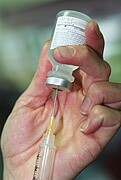| 
Painkiller May Prevent Diabetes-Related Retinal Damage

WEDNESDAY, Sept. 24 (HealthDay News) -- The painkiller pentazocine may help prevent diabetes-related retinal damage that leads to vision loss, according to Medical College of Georgia researchers.
"The effects of this drug on retinal health are phenomenal," Dr. Sylvia Smith, a retinal cell biologist and co-director of the Vision Discovery Institute at MCG's School of Medicine, said in a college news release.
For the study, she compared the retinas of diabetic mice treated with pentazocine and those that didn't receive the drug and found dramatic differences. The findings suggest that the drug and related compounds that bind with the sigma receptor in the eye may help treat the two leading causes of vision loss -- diabetic retinopathy and glaucoma.
The study was published in the September issue of the journal Investigative Ophthalmology & Visual Science.
Pentazocine's binding with sigma receptors didn't affect insulin levels in the diabetic mice.
"(The drug) does not solve that problem of diabetes; however, our findings do suggest that just because you are hyperglycemic does not mean you will have diabetic retinopathy," Smith said.
She and her team are collaborating with other MCG researchers to breed mice without a sigma receptor to learn more about the receptor's role and whether regular treatment with pentazocine will prove effective in mice with other types of retinal disease.
More information
The American Diabetes Association has more about diabetes-related eye complications  . .
|  |

Once-Weekly Diabetes Drug Boosts Blood Sugar Control

SUNDAY, Sept. 7 (HealthDay News) -- A new once-a-week formulation of the injectable diabetes drug Byetta controls blood sugar even better than the older twice-a-day formulation, researchers report.
"Besides obvious improved ease of use, [the new formulation] provided the remarkable advantage of both improved efficacy on glucose control and good gastrointestinal tolerability," said Dr. Andre Scheen of the University of Liege in Belgium, in a commentary accompanying the study's publication online Sunday in The Lancet.
The study, led by Dr. Daniel Drucker of Mount Sinai Hospital and the University of Toronto, Canada, is also slated for presentation Sunday at The European Association for the Study of Diabetes meeting, in Rome.
The findings, while encouraging, come on the heels of less-heartening news about Byetta (exenatide). On Aug. 26, the drug's makers, Eli Lilly and Amylin Pharmaceuticals Inc., reported the pancreatitis-linked deaths of four people who'd been taking the medication. That news came a week after the U.S. Food and Drug Administration said that two Byetta users had died of acute pancreatitis, a condition that can cause nausea, vomiting and abdominal pain.
While Byetta use has not been confirmed as a causative factor in these deaths, the FDA has noted an association between Byetta use and pancreatitis, and on Aug. 18 announced it was working on stronger labeling for the injected drug, which has been used by more than 700,000 people since being approved in June 2005.
The new study involved 259 patients with type 2 diabetes who received 30-week courses of either 2 milligrams of long-acting release Byetta given once weekly, or 10 microgram doses given twice a day. Researchers monitored blood sugar control via levels of hemoglobin A1C in the blood (HbA1c), which averaged 8.3 percent at the start of the study.
According to the researchers, HbA1c levels fell to a mean of 6.4 percent among the Byetta once-weekly group, versus 6.8 percent for those on the twice-daily regimen. More patients on the weekly dose achieved a target HbA1c level of 7 percent (77 percent) than those on the twice-a-day regimen (61 percent).
Overall, the once-a-week formulation provided patients with better blood sugar control than the twice-daily regimen, the authors wrote, "with no increased risk of hypoglycaemia and similar reductions in body weight."
The findings echo those from a similar study reported June 10 at the American Diabetes Association meeting in San Francisco. In their year-long study of 295 type 2 diabetics, researchers at the University of North Carolina School of Medicine, Chapel Hill, found that 74 percent of all participants achieved an HbAIc level of 7 percent or less -- regardless of whether they received Byetta once a week or twice daily.
More information
To learn more, visit the FDA.
|  |

U.S. Obesity Epidemic Continues to Grow
 THURSDAY, July 17 (HealthDay News) -- Despite wide-ranging efforts to encourage Americans to lose weight, the number of U.S. adults who are obese increased almost 2 percent between 2005 and 2007, a new report found.
In 2007, 25.6 percent of adults reported being obese, compared to 23.9 percent in 2005, according to the finding in the July 18 issue of the U.S. Centers for Disease Control and Prevention's Morbidity and Mortality Weekly Report.
"The epidemic of adult obesity continues to rise in the United States, indicating that we need to step up our efforts at the national, state and local levels," Dr. William Dietz, director of CDC's Division of Nutrition, Physical Activity, and Obesity, said in a news release. "We need to encourage people to eat more fruits and vegetables, engage in more physical activity and reduce the consumption of high-calorie foods and sugar-sweetened beverages in order to maintain a healthy weight."
The percentage of adults who are obese varies by state and region, according to the report. For example, in Alabama, Mississippi and Tennessee, 30 percent of the residents reported being obese, compared with 18.7 percent in Colorado, which had the lowest prevalence of obesity.
Obesity was most prevalent in the South, with 27 percent of residents classified as obese. In the Midwest, the number was 25.3 percent; in the Northeast, 23.3 percent; and in the West, 22.1 percent, according to the report.
In terms of age, among those 50 to 59 years old, 31.7 percent of men and 30.2 percent of women were obese. For those 19 to 29, 19.1 percent of men and women were obese.
Breaking the numbers down by race/ethnicity and sex, obesity prevalence was highest for non-Hispanic black women (39.0 percent), followed by non-Hispanic black men (32.1 percent).
Education levels play a role, too. For men, obesity prevalence was lowest among college graduates (22.1 percent) and highest among those with some college (29.5 percent) and a high school diploma (29.1 percent). For women, obesity prevalence was lowest among college graduates (17.9 percent) and highest among those with less than a high school diploma (32.6 percent).
None of the states or the District of Columbia has met the "Healthy People 2010" goal of reducing the prevalence of obesity to 15 percent or less, the CDC said.
"Obesity is a major risk factor for a number of chronic diseases such as type 2 diabetes, heart disease and stroke. These diseases can be very costly for states and the country as a whole," Deb Galuska, associate director for science at the CDC's Division of Nutrition, Physical Activity and Obesity, said in a news release.
The CDC defines obesity as a body mass index (BMI, a ratio of weight to height) of 30 or above. An adult who is 5-feet, 9-inches tall is considered obese if he or she weighs 203 pounds.
In compiling the data, the CDC used its Behavioral Risk Factor Surveillance System, which collected information on more than 350,000 adults through telephone interviews. The researchers calculated BMIs using information reported by survey participants.
"These data from the CDC confirm that the epidemic of obesity continues to spread, whether looking at population trends in the short- or long-term," said Howard D. Sesso, an assistant professor of medicine in the Division of Preventive Medicine at Brigham and Women's Hospital in Boston.
The likelihood of America meeting the Healthy People 2010 objectives for obesity prevalence appears dim, Sesso said. "This report highlights the need not only to outright prevent the development of obesity over the life-course, but also to improve efforts to reduce body weight in those already classified as obese," he said.
More information
For more on obesity, visit the CDC.
|  |
|